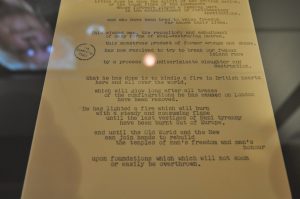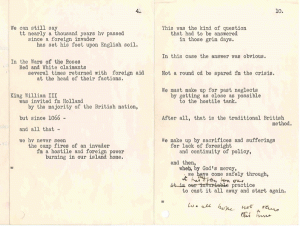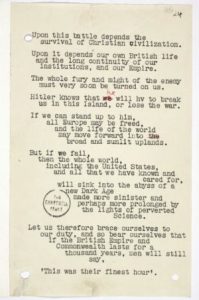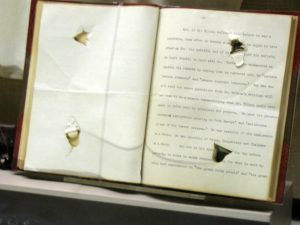36 Speaking from a Manuscript: How to Read Without Looking Like You Are Reading
Lynn Meade

How to Write and Use Manuscripts
There will be times when reading from a manuscript is helpful. When giving a eulogy and you are likely to experience strong emotions, having your words written out and in front of you will be very helpful. Politicians often speak from manuscripts because there will be people weighing the meaning of each word. They often have speech writers who take their ideas and make them sound professional, and they likely have several people look it over for any offensive words or questionable phrases.
The advantage to speaking with a manuscript is you have your speech in front of you. This gives you an opportunity to plan interesting wordplays and to use advanced language techniques. By managing the exact wording, you can better control the emotional tone. Another advantage to using a manuscript is you can share your speech with others both for proofing and for reference. For example, many people like to have written copies of the toast given to them at a special occasion or a copy of the eulogy to the loved one. Politically speaking, a manuscript can be helpful to help keep you on track and to help you say only the things that you mean to say.
The disadvantage to a manuscript is if not done properly, your speech may feel like an “essay with legs.” Speaking from a manuscript is a skill; I would argue that it is one of the most difficult of all types because your goal is to read without appearing to read. It can be so tempting to lock eyes on the page where it is safe and then never look up at the audience. Finally, it is very difficult for most people to gesture when reading a manuscript. Many people run their hands down the page to keep their place while others clutch the podium and never let go. These disadvantages can be overcome with practice. You can be dynamic and engaging while using a manuscript, but it does take work.
Keys to Using a Manuscript
- Always write a manuscript in manuscript format and never in essay format. (It should look like poetry).
- Practice your speech at a podium so you can figure out how to change pages smoothly.
- Learn the art of eye fixations.
- Practice with a friend so you can master eye contact.
- If you struggle with gestures, make a note on your manuscript to remind you to gesture.
- Practice, practice, practice–you should actually practice more than in a typical speech since it is a harder delivery method.
Formatting a Manuscript
- Do not start a sentence on one page and then finish it on another.
- Do not fold the manuscript–it won’t lay flat on the podium.
- Do not print on both sides of the page.
- Do not staple the manuscript
- Number your pages.
- Use a large font and then make it one size larger than you think you need.
- It should look like poetry.
- Have extra spaces between every main idea.
- Bold the first word of every main section.
- Use /// or …. to indicate pauses in your speech.
- Emphasize a word with a larger font or by making it bold.
- If you have a parallel construction where you repeat the same word, bold or underline the repeated word.
- Use an easy-to-read font.
- Make a note (SLIDE) when you need to change your slide.
- It is OK to omit punctuation.
- Do whatever formatting works best for you.
Sample manuscripts
Notice how this student formats her manuscript by making it spread out and easy to read:
Today // it is an honor for me to stand here before you
at the Freedom Banquet
and pay tribute to a man
,,,,,,,,,,,,,,,,,,that in his lifetime
………………………………….has touched
…………………..and changed
……………………………uncountable lives across the globe
Today /// we are here to honor
…………….a president,
………………………..a father,
………………………………a husband
…………………………………….and a true savior
in Mr. Nelson Rolihlahla Mandela
Tribute speech by Tanica van As delivered at the University of Arkansas
Manuscript From History


Winston Churchill’s Speech in Response
to German’s Invasion of Britain and Finest Hour Speech
Sometimes referred to as the Psalms format or free verse format,
the speech is written like it will be spoken.
How to Present with a Manuscript
To best read a manuscript, we need to borrow some items from speed reading. When you were first learning to read, you learned to read each letter–D–O–G. You would look at the letter “D,” then your eyes would look at the letter “O, ” and finally, your eyes would move over to look at the letter “G.” You would fixate (or rest) your eyes on three different places. Eventually, you got better at reading and better at seeing, so you would now look at “dog” in one eye fixation and your brain was able to take in the information–dog. Now, you no longer read one letter at a time, that would be way too slow. Now you look at all three letters and see it as a word.
Over time, you learned to see bigger words–like “communication” (13 letters). Now, consider this… the phase “The dog ran fast” contains 13 letters. Since you can see the word “communication” as one eye fixation and understand it as one thing, in theory, your eyes should be able to see “the dog ran fast” as one eye fixation and understand it too. We have been trained to look at each word individually with separate eye fixations. For example, …the … dog… ran… fast… is four different eye fixations. With a little practice, you can train your eyes to see the whole phrase with one look. Here are some sentences, practice looking at each of the sentences with one eye fixation.
I ate the red apple
My car is green
My cat is moody
You tried it didn’t you? You can only learn if you try them out. If you didn’t try it, go back and look at those sentences again and try to see the whole sentence with one look. With practice, you can look at an entire sentence as one thing (eye fixation). Your brain can understand all those words as one thought. Now, try this. Wherever you are right now, look up at the wall nearest you and then look back down. Write down all the things you can recall about what you saw–I saw a yellow wall with brown trim, two bookcases, a clock, a printer, a bird statue. Your brain is amazing; it can look up to a wall and in one eye fixation, it can take in all that it sees.
You can take in many sentences as well. You can actually see two sentences in one look. Try to look down at these next two sentences in one eye fixation. Test yourself by looking down and then looking up and saying what you remember out loud.
The boy sang a song
The girl danced along
With a little practice, most people can see chunks of five words across and three lines down. Give it a try. Once again, try to look at the three sentences as one and then look up and say them.
The happy frog leaped
off the lily pad
and into the cool water
It takes practice, but you can do it. The bonus feature of doing the practice and learning this skill is you will learn to read faster. Since a lot of college work and professional preparation relies on reading the information, it would benefit you for the rest of your life to learn this valuable skill. While researching, I came across this excellent slide presentation by Sanda Jameson on Reading for College that goes into more depth about the process. I highly recommend you review it to help you with your manuscript reading and to help you become a better reader in your college classes.
https://www.nwmissouri.edu/trio/pdf/sss/study/Reading-for-college.pdf
By now, you have figured out that using chunking and working on eye fixations is going to help you read your manuscript easier. Arranging your manuscript where you have only five to seven words on a line will make it easier to see as one fixation. Organizing your manuscript where you can see several lines of text at once, can help you put a lot of information in one eye fixation.
Now, let’s look at a eulogy written by one of my students, Sydney Stout. She wrote this eulogy to her grandpa who loved dancing and encouraged her to do the same. First, notice the manuscript format where it is written like it will be spoken. It is chunked into lines that are usually 5-7 words long. The list of names is written like a stair step showing the stair step in the voice when the names are spoken. Try reading this except out loud focusing on eye fixations. Try to see one whole line at a time and then read it again trying to see two lines at a time.
Dancing is a delicate art
An activity many people love and enjoy
but someone that loves dancing
more than anyone I know
is my grandfather.
You all know my grandfather
Maybe you know him as James
….. Jack
………Dad
………….Papa Jack
…………………or in my case……………….. just Papa.
Papa // you have led me through life
like any great dance partner should
And I’ve memorized the steps you’ve taught me
……………………………………….….And they have allowed me to dance
………………………………………………………………gracefully
…………………………………………………………..through my own life
Tribute speech by Sydney Stout delivered at the University of Arkansas
Examples
Watch this eulogy speech to Rosa Parks by Oprah Winfrey. Notice how each word is carefully chosen and how if you notice closely, you can tell that she is using a manuscript. Notice how seamlessly she turns the pages and notice how she spends most of her time looking up at the audience. Masterfully, she uses gestures to enhance the rhythmic flow o the speech and to draw the audience’s attention.
Timing Your Manuscript
Practice your manuscript at least 5 to 7 times. Trust me when I say, It is harder to speak with a manuscript than it is to give a speech with brief notes and it requires considerable more practice to get it right.
Use this chart as a general reference for the timing of your speech to the length of your manuscript.
| 390 words in a 3- minute speech |
| 650 words in a 5- minute speech |
| 1300 words in a 10- minute speech |
| For More http://www.speechinminutes.com/ |
A Speech Saved the President’s Life

Teddy Roosevelt’s life was saved when an assassin’s bullet was slowed down by his 50 paged speech manuscript. The doctor on sight determined that although the bullet didn’t puncture his lungs, he should still go to the hospital immediately. A determined Roosevelt balked and said, “You get me to that speech.” He delivered a 50-minute speech before going to the hospital. Doctors decided it was safer to leave the bullet in his chest and declared that his speech had indeed saved his life.
More on this story from the history channel: https://www.history.com/news/shot-in-the-chest-100-years-ago-teddy-roosevelt-kept-on-talking
Please share your feedback, suggestions, corrections, and ideas.
I want to hear from you.
Do you have an activity to include?
Did you notice a typo that I should correct?
Are you planning to use this as a resource and do you want me to know about it?
Do you want to tell me something that really helped you?
References
Klein, C. (2019). When Teddy Roosevelt was shot in 1912, a speech may have saved his life. https://www.history.com/news/shot-in-the-chest-100-years-ago-teddy-roosevelt-kept-on-talking
Speech in minutes. (n.d.). http://www.speechinminutes.com/
Stout, S. (n.d.). Eulogy to Papa with the theme of dancing. Delivered in Lynn Meade’s Advanced Public Speaking Class at the University of Arkansas. Used with permission.
Van As, T. (n.d.) Tribute to Nelson Mandela. Delivered in Lynn Meade’s Advanced Public Speaking Class at the University of Arkansas. Used with permission.
Winfrey, O. (2010). Eulogy to Rosa Parks. [Video] YouTube. https://www.youtube.com/watch?v=5cfhtfNfIPE Standard YouTube License.
Media Attributions
- Winston Churchill’s Manuscript is licensed under a CC BY-NC-ND (Attribution NonCommercial NoDerivatives) license
- Winston Churchill’s Speech in Response to German’s Invasion of Britain
- Winston Churchill Finest Hour Speech
- Teddy’s speech © Janine Eden, Eden Pictures is licensed under a CC BY (Attribution) license

